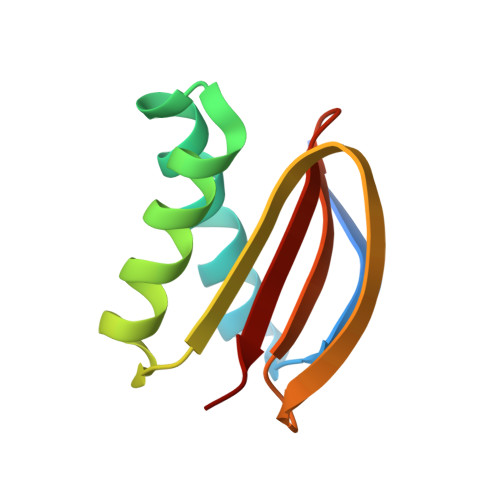Biochemical and structural characterization of the Pak1-LC8 interaction.
Lightcap, C.M., Sun, S., Lear, J.D., Rodeck, U., Polenova, T., Williams, J.C.(2008) J Biol Chem 283: 27314-27324
- PubMed: 18650427
- DOI: https://doi.org/10.1074/jbc.M800758200
- Primary Citation of Related Structures:
3DVH, 3DVP, 3DVT - PubMed Abstract:
Pak1 (p21-activated kinase-1) and the dynein light chain, LC8, are overexpressed in breast cancer, and their direct interaction has been proposed to regulate tumor cell survival. These effects have been attributed in part to Pak1-mediated phosphorylation of LC8 at serine 88. However, LC8 is homodimeric, which renders Ser(88) inaccessible. Moreover, Pak1 does not contain a canonical LC8 binding sequence compared with other characterized LC8 binding sequences. Together, these observations raise the question whether the Pak1/LC8 interaction is distinct (i.e. enabled by a unique interface independent of LC8 dimerization). Herein, we present results from biochemical, NMR, and crystallographic studies that show that Pak1 (residues 212-222) binds to LC8 along the same groove as canonical LC8 interaction partners (e.g. nNOS and BimL). Using LC8 point mutants K36P and T67A, we were able to differentiate Pak1 from canonical LC8 binding sequences and identify a key hydrogen bond network that compensates for the loss of the conserved glutamine in the consensus sequence. We also show that the target binding interface formed through LC8 dimerization is required to bind to Pak1 and precludes phosphorylation of LC8 at Ser(88). Consistent with this observation, in vitro phosphorylation assays using activated Pak1 fail to phosphorylate LC8. Although these results define structural details of the Pak1/LC8 interaction and suggest a hierarchy of target binding affinities, they do not support the current model whereby Pak1 binds to and subsequently phosphorylates LC8 to promote anchorage-independent growth. Rather, they suggest that LC8 binding modulates Pak1 activity and/or nuclear localization.
Organizational Affiliation:
Department of Biochemistry and Molecular Biology, Thomas Jefferson University, Philadelphia, Pennsylvania 19107, USA.















